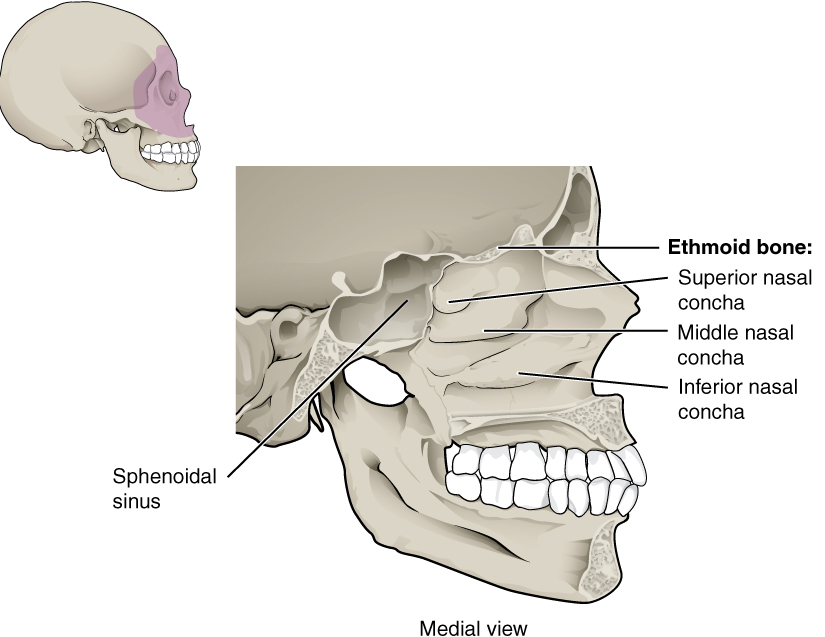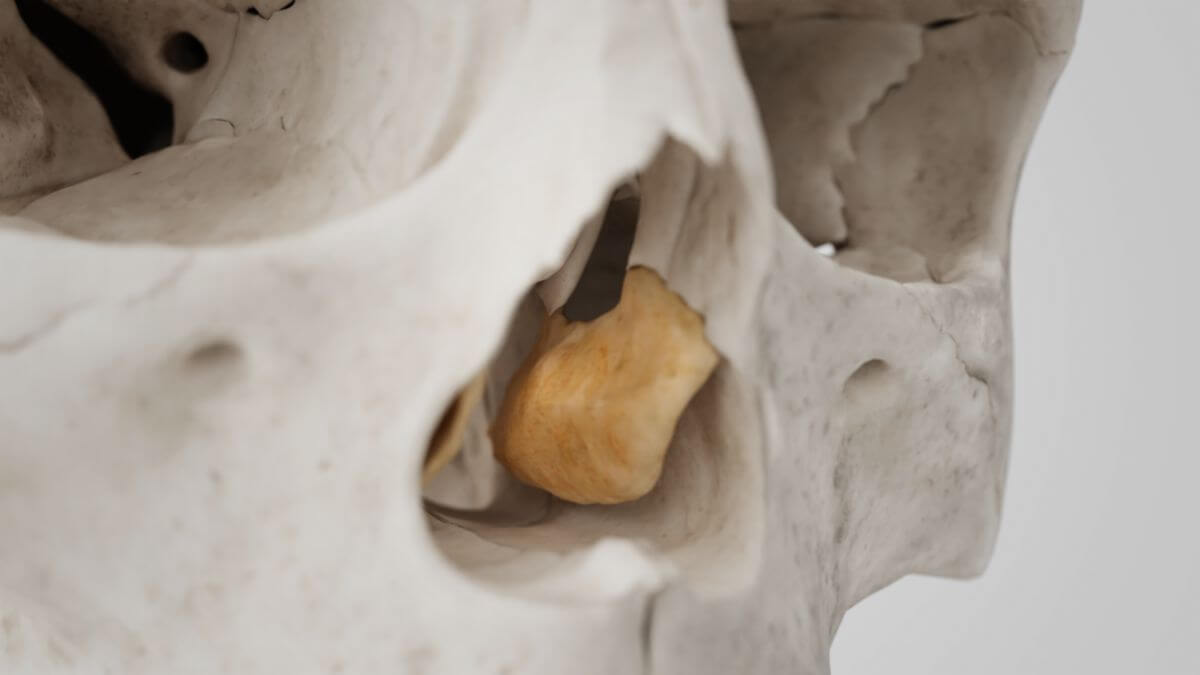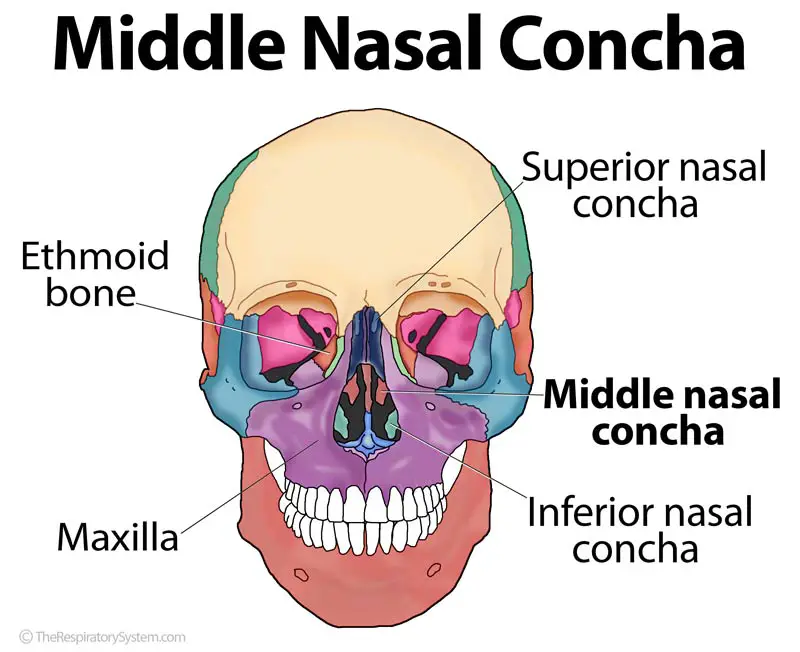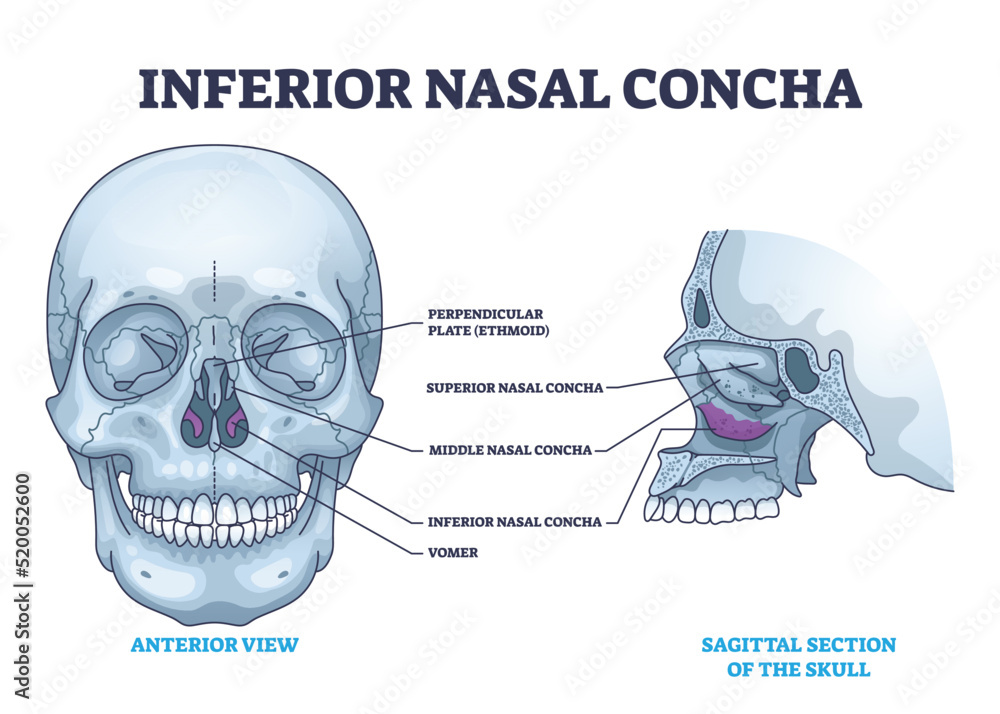
Pin on Anatomy/OTA/Study Guide
A concha is any of the scrolled spongy bones of the nasal passages in vertebrates. [3] In humans, the conchae divide the nasal airway into four groove-like air passages, and are responsible for forcing inhaled air to flow in a steady, regular pattern around the largest possible surface area of nasal mucosa.
:background_color(FFFFFF):format(jpeg)/images/library/358/Inferior_nasal_concha.png)
Inferior Nasal Concha Anatomy, Definition & Development Kenhub
Located along the lateral walls of the nasal cavity, there are three pairs of turbinates commonly described: superior, middle, and inferior.[1] Additionally, between 8% and 80% of patients will possess either a unilateral or bilateral supreme turbinate as well.[2][3] The bony components of the turbinates are referred to as conchae; the conchae of the middle, superior, and supreme turbinates.

The Skull · Anatomy and Physiology
The nasal conchae or turbinates are long, narrow curled shelves of bone that protrude into the nasal cavity. The superior, middle and inferior conchae divide the nasal cavity into four groove-like air passages. Their position and relationship to other important anatomic landmarks are extremely important especially in skull base and ENT surgical.

Concha nasalis inferior DocCheck Flexikon
Anatomy The inferior nasal conchae are a pair of bones, with one concha on either side, that separates the middle and lower nasal meatus, or nasal cavity. They are often described as being "spongy" bones. While the superior and middle nasal conchae are technically part of the ethmoid bone, the inferior nasal concha forms a completely separate bone.

Concha nasalis inferior
The viscerocranium is a collection of bones that make up the face skeleton. It is named in contrast to the neurocranium (braincase), or the bones of the skull that accommodate the human brain . The face skeleton includes 14 facial bones (6 paired and 2 unpaired) with specific anatomical landmarks and embryological development.

Middle Nasal Concha The Respiratory System
The turbinates are also called the nasal conchae. If the turbinates are too large, they can actually block airflow. Doctors call this condition turbinate hypertrophy. This condition can cause.

Nose And Sinus Anatomy
The inferior nasal conchae (inferior turbinated bone or inferior turbinal/turbinate) is a bone inside the nose. There are three of them inside your nose. It goes along the side wall of the nasal cavity. It is a lamina of spongy bone, curled upon itself like a scroll, (turbinate meaning inverted cone). : Head (body part)

Concha nasalis inferior
What is the Inferior Nasal Concha The inferior nasal concha is a small, paired facial bone. It is one of the three bony structures that form the lateral wall of the nasal cavity, the other two being the superior and middle conchae. Unlike these two, the inferior nasal concha is an independent bone in the skull. Where is it located

VERTEBRA PROMINENS TUBERCULUM MAJUS MINUS TUBERCULUM LATERALE MEDIALE
The inferior nasal concha (also called the inferior turbinate, inferior nasal turbinate, Latin: concha nasi inferior, concha nasalis inferior) is a paired bone in a form of a horizontal curved plate situated in the lateral wall of the nasal cavity.
/images/library/6236/4sOCjDagHOqglEzog4kiA_Concha_nasalis_inferior_02.png)
Inferior Nasal Concha Anatomy, Definition & Development Kenhub
Concha nasalis inferior Quick Facts Key Features & Anatomical Relations Ossification Variations List of Clinical Correlates References Quick Facts Location: Viscerocranium. Bone Type: Irregular bone. Key Features: Medial and lateral surfaces, superior and inferior borders, and lacrimal, maxillary, and ethmoidal processes.

Inferior nasal concha YouTube
Concha nasalis inferior Synonym: Inferior nasal turbinate Related terms: Inferior nasal concha Definition The inferior nasal concha extends horizontally along the lateral wall of the nasal cavity and consists of a lamina of spongy bone, curled upon itself like a scroll. It has two surfaces, two borders, and two extremities. Gallery

Inferior Nasal Concha Prohealthsys
The inferior nasal conchae are considered a pair of facial bones since they articulate with their respective maxillae bones and project horizontally into the nasal cavity. Superior to the inferior nasal conchae are the middle nasal conchae and superior nasal conchae.

Concha nasalis inferior
The inferior nasal concha is ossified from a single center, which appears about the fifth month of fetal life in the lateral wall of the cartilaginous nasal capsule. [citation needed] The entire inferior concha may be absent in some people. This is a consequence of embryologic agenesis and is a normal anatomic variant. Clinical significance

Sphenoethmoidal recess in Middle & Superior conchae (Note Different structures openi… Human
The are three conchae - inferior, middle and superior. They project into the nasal cavity, creating four pathways for the air to flow. These pathways are called meatuses: Inferior meatus - between the inferior concha and floor of the nasal cavity. Middle meatus - between the inferior and middle concha.
:watermark(/images/watermark_only.png,0,0,0):watermark(/images/logo_url.png,-10,-10,0)/images/anatomy_term/superior-nasal-concha/SJkeTW0VYuIApVFSyebZtA_Concha_nasalis_superior_02.png)
Concha nasalis superior (obere Nasenmuschel) Kenhub
The inferior nasal concha is one of the three paired nasal conchae in the nose. It extends horizontally along the lateral wall of the nasal cavity and consists of a lamina of spongy bone, curled upon itself like a scroll, . The inferior nasal conchae are considered a pair of facial bones. As the air passes through the turbinates, the air is churned against these mucosa-lined bones in order to.

Vettoriale Stock Inferior nasal concha location with human nose area anatomy outline diagram
Concha nasalis inferior. The inferior nasal concha is the delicate paired bone attached to the lateral wall of the nasal cavity. The inferior nasal concha separates the middle nasal meatus from the inferior one, affecting the airflow in the nasal cavity 1 and the maxillary sinus 2. 1 Kelly J, et al. Detailed flow patterns in the nasal cavity.